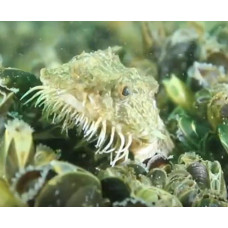Latin name
Agonus cataphractus
Other name
Pogge or armed bullhead.
Identification
The Hooknose broad head and body are covered with stiff bony plates that limit its flexibility. There are two hook-shaped sharp spines on the snout and stout spines on the gill covers. On the underside of the head and snout are numerous small, brightly colored antennae. The unpaired row of thoracic plates is absent, but paired rows of plates cover the entire thorax. Numerous antennae on gill and dorsal membranes. Number of dorsal plates 31-34. No spines on posterior part of head.
Features of fish fins
There are 5-6 hard and 6-8 soft rays in the dorsal fin and 5-7 soft rays in the anal fin. The pelvic fins are short. The spiny and soft dorsal fins are almost fused.
Fish colouring
The coloration of the dorsal side of the hooknose is dark brown with 4 or 5 dark saddle spots, the ventral side is creamy white. During the spawning season the pectoral fins become orange.
Distribution
Occurs in coastal waters of the northeast Atlantic from the English Channel to the coasts of northern Norway and the White Sea, in the southern part of the Baltic Sea, off the Shetland and Faroe Islands, and off the southern and southwestern coasts of Iceland.
Habitat
A marine demersal species. The depth range of its habitat is from 0 to 270. Prefers waters with a temperature of +4...+12 °C. It lives in coastal waters.
Size
The total length of fish of this species can reach 20.7 cm, but usually does not exceed 10-15 cm. The maximum recorded lifespan is 3 years.
Behavior
Hooknose are found on sandy and muddy bottoms at depths down to 20 meters, but in winter they migrate to deeper waters down to 270 meters. Juveniles are found at shallower depths, even as shallow as 2 meters along the shore.
Food and feeding habits
Hooknose feeds primarily on small crustaceans, bristle worms, small mollusks and brittle stars.
Reproduction
They become sexually mature at one year of age, some spawning for the first time at two years of age. Spawning occurs from February to April-May. Females lay 2,500-3,000 yellow eggs, 2 mm in diameter, on brown algae (at the base of rocks, according to other sources). Egg development takes 10-11 (sometimes up to 12) months. The larvae hatch at 6-8 mm long, pelagic, but when they reach 2 cm in length they switch to a benthic lifestyle.
Fishing
This species has no commercial importance, although it is caught in shrimp trawls.
Relationship with a person
Harmless.
Interesting Facts
Protective coloration helps eggs (roe) avoid predators. In fish that spawn on sandy bottoms, the eggs are usually yellow, while floating eggs are transparent. However, the Hooknose lays orange eggs inside orange sponges.
| Classification | |
| Phylum | Chordata |
| Class | Actinopterygii |
| Squad | Perciformes |
| Family | Agonidae |
| Genus | Agonus |
| Species | A. cataphractus |
| Features | |
| Conservation status | Least Concern |
| Habitat | Bottom |
| Life span, years | 3 |
| Maximum body weight, kg | No information |
| Maximum length, cm | 20,7 |
| Sailing speed, m/s | No information |
| Threat to people | Edible |
| Way of eating | Planktonophage |
Hooknose
Tags: hooknose


